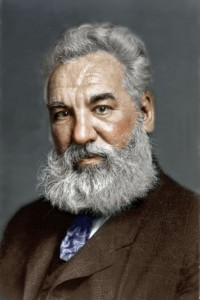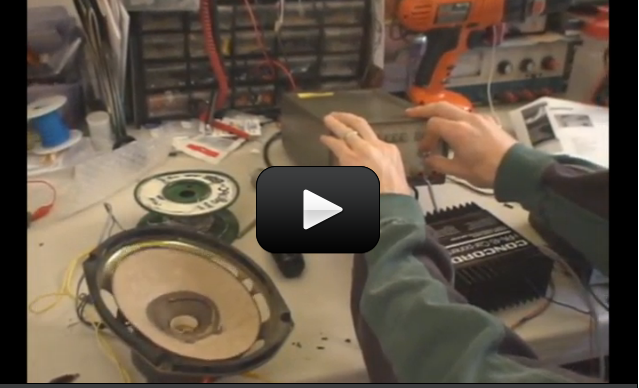 Alexander Graham Bell developed the telegraph, microphone, and telephone back in the late 1800s. We'll be talking about electromagnetism in a later unit, but we're going to cover a few basics here so you can understand how loudspeakers transform an electrical signal into sound.
Alexander Graham Bell developed the telegraph, microphone, and telephone back in the late 1800s. We'll be talking about electromagnetism in a later unit, but we're going to cover a few basics here so you can understand how loudspeakers transform an electrical signal into sound.
This experiment is for advanced students.We'll be making different kinds of speakers using household materials (like plastic cups, foam plates, and business cards!), but before we begin, we need to make sure you really understand a few basic principles. Here's what you need to know to get started:


If everything is the same, all the speakers would have the same volume.
Which speaker would be the loudest if they all had the same number of magnets, the same type of magnets, and the same wire gage, and the same number of turns?
Be sure to confirm that the enamel is thoroughly sanded from the two ends of the magnetic wire. Also, with your audio plug, I recommend connecting to the black and red wires. If you have the audio plug from Amazon, then black is negative, red is for the right channel and white is for the left channel. If it still isn’t working, please email pictures of your full set up to [email protected].
Several questions. We tried to do this experiment but it didn’t work. Our audio plug doesn’t match the one in the video but is the same as the one on the worksheet. It has the white, black and red wire at the end. How do you hook it up properly?
Second we have a boom box but it’s a newer one. Would that be causing the problem or is it the audio cord?
It is called function generator.
what is the machine that makes the noise called
The best way to increase the impedance (resistance) of the speaker is to add more windings of wire. But, as you mentioned, you can increase the resistance by adding a resistor. This part shouldn’t be more than a few dollars, or even less than a dollar depending on the resistor value. As a side note, be careful not to move a magnet back and forth across your speaker coil while it is connected to an IC or stereo system. Moving the magnet back and forth will induce an electrical current high enough to fry your IC or parts of your stereo amplifier.
Yes, you can, opt for the thinnest insulation you can find.
Can you use regular electric wire instead of magnetic wire?
Update:
We used a 100ohm resistor and got a quiet sound. We will buy a 50 ohm resistor and see if it works.
Thanks,
Sasha
Hi Aurora,
We built a speaker and modified a lot. After that, we tested it with a small IC chip that generated sounds. Tha IC of course burned, but we didn’t care about it anyways. The speaker worked with the IC for a few minutes before it stopped and the IC was unresponsive. What can we do to increase the resistance of the speaker? We tried some resistors with a different IC and it did not work. We also looked for the 8 ohm resistor but one of them costs $40. What is a relatively cheap way to increase resistance? We have a lot of electical components at home.
Thanks,
Sasha
ok thanks.
Look in the shopping list for Unit 14 – they are the neodymium magnets. There should be an order link as well for easy purchase.
I couldn’t find the rare the magnets in my kit. Did you send them, or do I need to buy some? If so, where can I find them?
I did the expirement without the springs and it works.
Thanks
No – the crystal radio needs an earphone that is non-magnetic since the signal is sooo low power. You can read about the different kinds of speakers in Unit 6.
Can I use this use this for the crystal radio?
Forgot to mention this earlier – you can attach a plug from Radio Shack and then you’ll be able to plug it into any stereo. Simply attach the end of each wire from your homemade speaker to the end of each wire from the plug and it should work just fine.
Or, if you’re like me and you don’t want to wait to go to the store, attach one alligator clip lead to the end of each of the two wires from the speaker and attach one to the outside metal part of the jack and the other shoved into the center (be gentle so you don’t break anything). That should do the trick. Let me know how it goes!
The only stereo that’s close to no plug is one that takes plug and battery’s. Will that work?
You connect the two wires from the coil to the speaker inputs at the back of the stereo. You’ll need ones that don’t require a plug – the kind where you can simply insert bare wire into the contacts. Flip your stereos around and see if anything looks like it would be a terminal (contact) you can connect bare wire to. If you still have trouble, you can always attach an alligator clip to the bare wire and clip the other end of the alligator clip lead in the hole – just make sure you’ve got a good metal-to-metal contact.
Question… how do you plug it in to the radio!
Yes, that’s right – only it moves so quickly you often don’t see it (but you can feel it). Watch the first video and you’ll see what I mean. The great experiment for a science fair project would be to build several speakers and vary just one aspect of them, like the power of the magnet, or the number of coils, or the size of the speaker, etc.
To show how sound waves move through the air, fill a long tube halfway with water, wrap each of the ends with something flexible like saran wrap (so it resembles a drum head), and stretch a rubber band over one end. Lay the tube on its side (make sure it does not leak!) and then snap the rubber band on the drum head and watch the waves move down the tube on the surface of the water. You can talk about how bats use this principle to “see” at night…
I’ve always wondered why speakers have magnets in them, do the magnets help the speakers to move?
And I’m going to do a science project on sound waves, and I can’t decide what experiment really would be the best to use to help explain the topic. Do you have any suggestions?
Rian
Look like our server had a hiccup. Go ahead and try again.
Hi,
The videos are not coming up for me; however, the YouTube videos are coming up okay. The videos for Unit 5, Sound, came up just fine for me yesterday. I have tested with new browser sessions under IE8, Chrome, and Firefox.